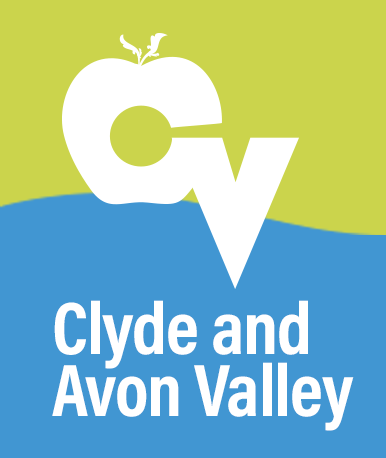Cyanotype Photography
A how to guide
Filed under Art, Literature & Song
A cyanotype is an early type of photography that uses sunlight to develop the picture. A special solution of ferric ammonium citrate and potassium ferricyanide are brushed on to a piece of paper or cloth. Objects like flowers or photo negatives are arranged on the treated paper and left out in the sun. The chemical solution reacts with UV rays from the sunlight to turn a lovely dark blue colour. Anywhere that is blocked from the sun by objects will remain white. This guide will help you make lovely creative images at home!

What you need:
- Heavy, absorbent paper like watercolour paper, or a canvas.
- Photosensitive solution (described below).
- A paintbrush.
- Some objects like feathers, leaves, bits of metal, paper shapes, etc.
- Photo negatives printed on overhead projector film (optional).
- A sunny window or space outdoors.
- A sink and running water.
STEP 1: The Photosensitive Solution
In order to make a cyanotype at home you must purchase the cyanotype chemicals. These are quite safe, however please do take care when using them. Wear gloves and old clothing when handling them, as they can stain your skin and clothing blue. Don’t use any utensils to mix the chemicals that you also use for food. An old takeaway container and a dedicated set of measuring spoons for mixing is just fine. Take care not to get any of the solution on anything you do not want stained. ,
The chemicals used to make the solution are easily available online. You can purchase pre-mixed solution, which is the easiest way when beginning to make cyanotypes, or you can buy the different chemical powders separately and mix them yourself.
For pre-mixed solution one U.K. supplier is: http://cyanotype.co.uk/cyanotype1.html
If buying the powders you will need to purchase: Ferric Ammonium Citrate (FAC) and Potassium Ferricyanide (PF).
A supplier can be found by following these links: http://www.wetplatesupplies.com/alternative-processes/cyanotype/potassium-ferricyanide.html http://www.wetplatesupplies.com/alternative-processes/cyanotype/ammonium-ferric-citrate-green.html
Remember to read and follow all the safety information associated with these chemicals. Once you have purchased your chemicals you will need to follow the following recipe to make your solution:
In one bottle, combine 25g of Ferric Ammonium Citrate with 100mL of water (preferably demineralised, and never hard water). In another bottle, combine 10g of Potassium Ferricyanide in 100mL of water. Close the bottles tightly and give a gentle shake to dissolve the powders. These can be store somewhere dark indefinitely, as long as the two solutions are not mixed. Once mixed together, they cannot be stored, and any unused mixture must be disposed of, along with their container, in a bin.
To make the photosensitive solution, mix an equal amount from the FAC bottle and from the PF bottle. In order to create two A4 size photo prints, for example, mix 1 tsp of FAC solution with 1 tsp of PF solution.
Note: This should be done after the sun goes down, in order for it not to react with UV light!
STEP 2: Preparing the paper
Take your photosensitive solution and brush a thin layer onto the watercolour paper. This will leave a light yellowish-green tint to the paper. Allow this to dry thoroughly, and then package the paper in a black plastic bag to keep it out of the light until you are ready to use it.
STEP 3: Setting up the print

When you are ready to create your print, choose your objects and negatives, and arrange them how you’d like your finished photo to look.
STEP 4: Creating the print

Take out your photosensitive paper, and arrange your objects and negatives on top of it. Set this in a sunny window, or outside for at least 10 minutes. Depending on the strength of the sunshine that day, the print can take anywhere from a few minutes to several hours to develop fully. Once the light green colour on the paper has turned a dark greenish-grey colour, your image is fully developed and you can move on to the next step.
STEP 5: Rinsing

Take your objects and negatives off the paper, and rinse it thoroughly in cool, running water. This will rinse away any undeveloped solution and reveal the blue image. Once the water runs clean, the process is complete, and you can set the paper aside to dry, or hang your photos on a line. The blue colour will deepen over the next little while.
Some problems you might have:
The image gets washed away in the final step: This is normally caused when the image has not been allowed to develop fully. Next time you try, allow the paper to sit in your window for a little while longer or wait for a sunnier day. You may need to test different times in order to get just the right amount of colour for what you want to achieve. Sometimes a light, ghostly image can be just as nice as a deep bold one!
The image is blurry: The objects or negatives need to sit flush on the paper, or else some light may be allowed underneath. This will cause a blurring effect. If it’s a windy day, you may want to place a pane of glass over your photo to keep everything in place.
Parts of your picture turn yellow or brown: The blue pigment left behind by the process will react with some of the ingredients in certain soaps. Make sure you rinse the image in water only, and if you hang it up on the clothesline to dry, make sure it’s with clean pegs.
Step 6: Share your finished images
Make sure to share your finished images with us on facebook, instgaram and twitter!
Read more

